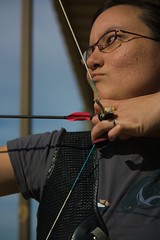Just like stories have structure, scenes have a specific structure, too. Story structure can help make sure your scenes matter; scene structure helps your scenes make sense. Your overall story might be on course, but if your scenes meander, readers will still feel lost.
Scene structure
 In his aptly-named book Scene & Structure, Jack Bickham delves into the scene structure proposed by Dwight Swain. The basic structure of any scene, Bickham says, is Goal – Conflict – Disaster.
In his aptly-named book Scene & Structure, Jack Bickham delves into the scene structure proposed by Dwight Swain. The basic structure of any scene, Bickham says, is Goal – Conflict – Disaster.
The Goal is the POV character’s goal at the start of the scene, for just that scene. (More about this later in the series!) The Conflict is what happens as the character pursues the Goal and meets resistance—dialogue, movement, pursuit, etc. The Conflict builds to the climax of the scene—the Disaster, when the character’s goal is frustrated.
Sequel structure
A scene is followed by a sequel, which has its own structure. Bickham’s structure for the sequel is Emotion – Thought – Decision – Action (which leads to another scene). The Emotion is the initial response to the events of the scene and its Disaster. When the character moves past the initial emotion, they think through the events, their response and their options in the Thought phase. This ultimately leads to a Decision, which takes the character to another Action—setting a goal for them.
Not all the steps of the sequel are necessary. In fact, the sequel itself might not be necessary—depends on the pacing and whether the emotional reaction constitutes a change. I often find my sequels very brief, or rolled into the beginning of the next scene.
How does all this help make your story stronger?
Scene structure is a basic good practice. Like I said at the beginning, it keeps scenes from wandering, and our readers’ attention spans from doing the same. It clues readers in from the beginning that the following does impact the story, keeping them hooked through the action.
As Bickham says it, the scene goal poses a question—will s/he get what he’s after? The character then pursues that goal until the disaster answers the question, most often with either “yes, but” (she achieves her intermediate goal, but a larger goal might have to be sacrificed) or “no, and furthermore” (not only does he not accomplish what he wanted, but now there are more problems!).
Our sequels motivate the next action. If you need a character do to something that might seem crazy next, the sequel is the place to give him or her a good reason, and to show the thought process, setting up the next goal and action. This pattern makes our scenes causally linked (instead of casually linked)—creating a plot instead of a sequence of events.
Believe it or not, this pattern can become so ingrained that it’s second nature. You still want to check to make sure you have the basics (more on that next week), but scene structure is so prevalent in modern literature that once you notice it, it’s easy to mimic, even on a subconscious level.
What do you think? How does the structure of scenes and sequels influence your writing? Come share!
Photo by Tony Case
 Zach took a deep breath of the musty air of the small church. It was nothing like the chapels he was used to, of course, but he had act like this was his new home.
Zach took a deep breath of the musty air of the small church. It was nothing like the chapels he was used to, of course, but he had act like this was his new home.



 For example, if we need our character to go from shocked after the last disaster to furious in the sequel, we start with that initial emotional response—the shock. We don’t have to spend a long time exploring the shock, especially if that’s the kind of reaction you’d expect in light of the disaster. Once we create a vivid picture of the shock (and that’s a toughie, since it’s characterized by the absence of feeling, really), we can give the character a minute to get her bearings again.
For example, if we need our character to go from shocked after the last disaster to furious in the sequel, we start with that initial emotional response—the shock. We don’t have to spend a long time exploring the shock, especially if that’s the kind of reaction you’d expect in light of the disaster. Once we create a vivid picture of the shock (and that’s a toughie, since it’s characterized by the absence of feeling, really), we can give the character a minute to get her bearings again.